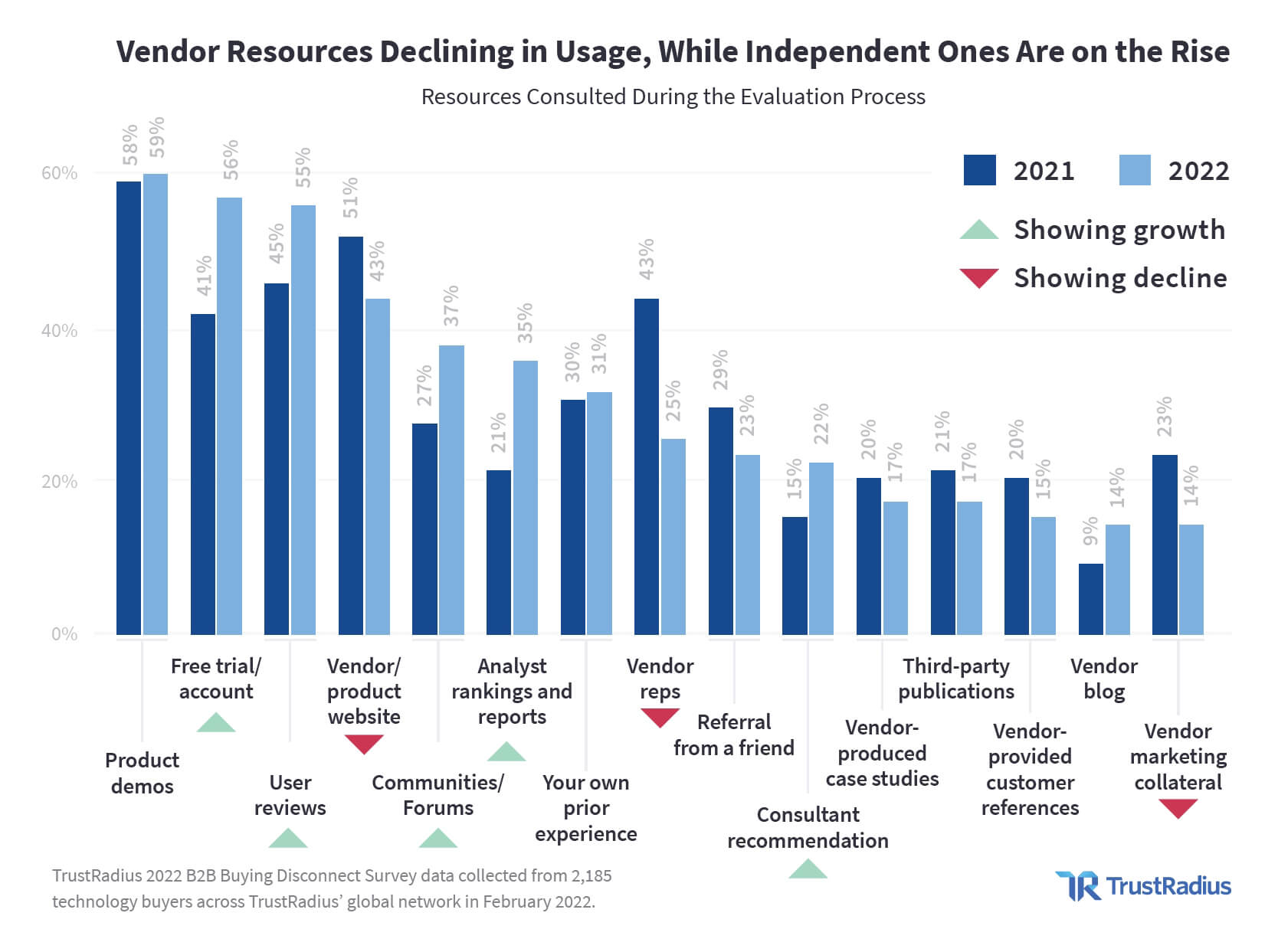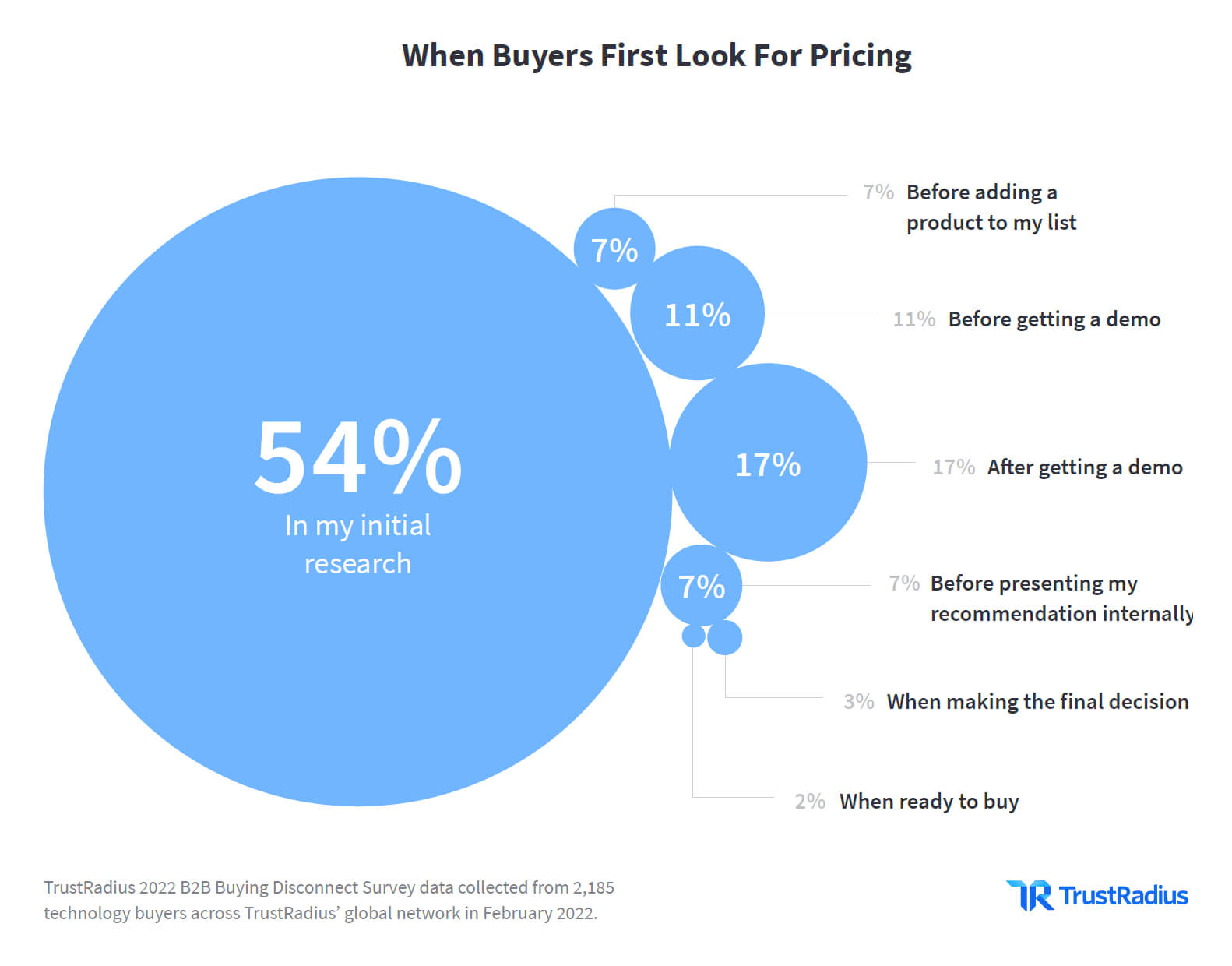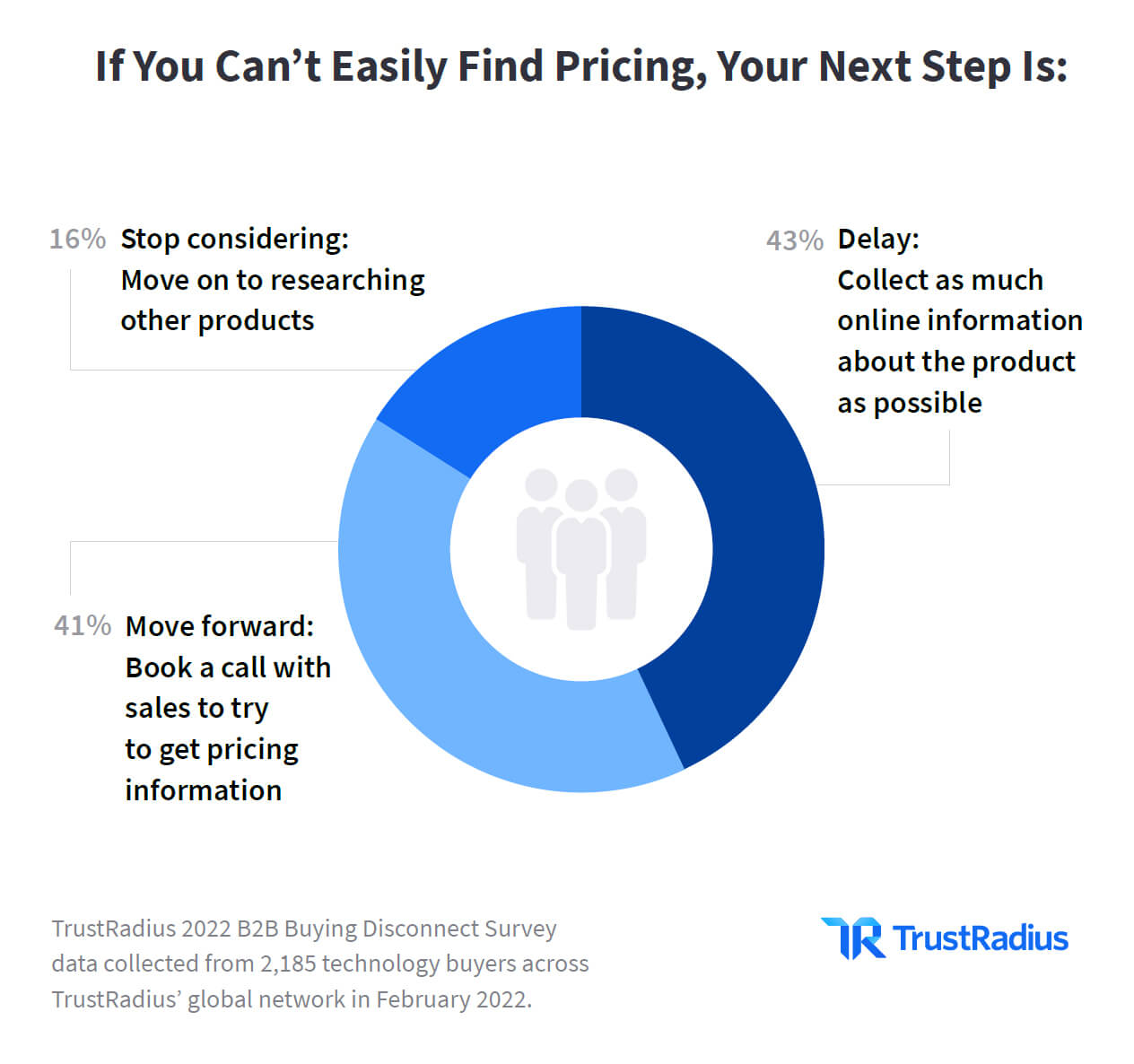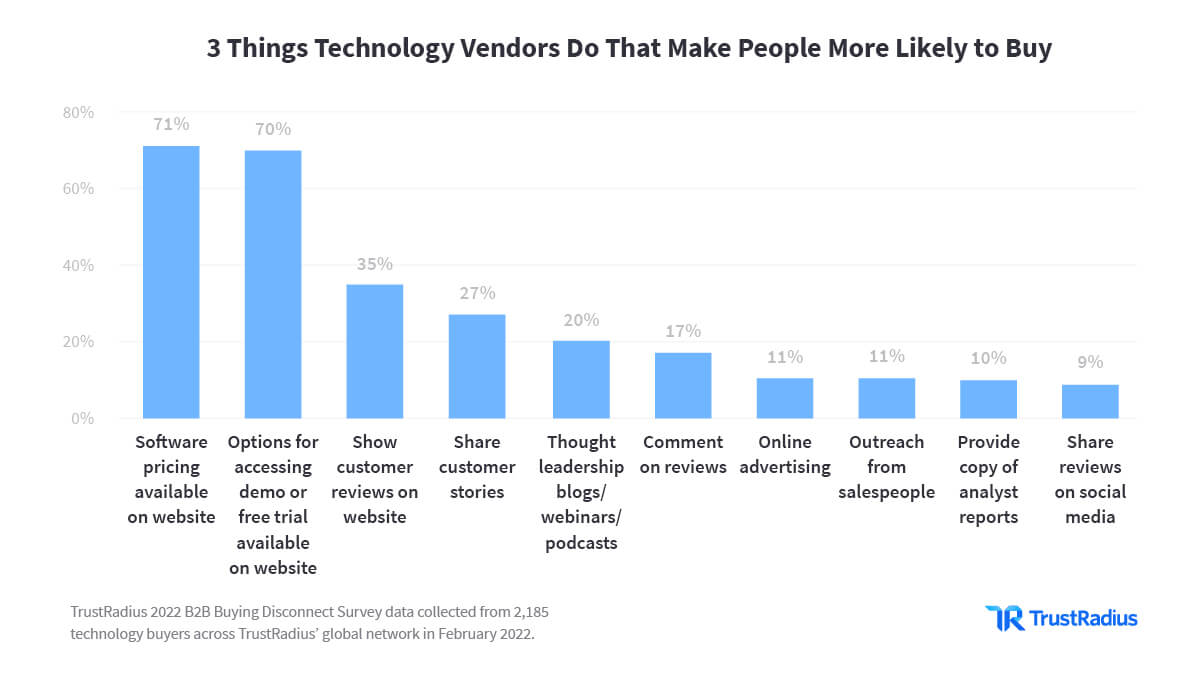
4 Ways to Win and Retain Your B2B Customers
Marketers are always striving to delight their customers. However, attaining unparalleled levels of customer satisfaction requires brands to go above and beyond in order to provide a cohesive customer experience.
Winning a customer in B2B differs from what you’d do in a conventional B2C space. First, you are sure that more than one person is making the purchase decision in B2B. Our findings suggest that B2B buying involves purchasing decisions made in groups of at least two persons in 95% of all instances.
Improving B2B sales requires a fine balance between winning new customers and retaining existing ones, however, most B2B organizations predominantly focus on marketing strategies to get new customers. However, with a looming recession, marketers have to strike the balance between new logo acquisition and customer retainment and growth. So, what should your approach be?
TrustRadius surveyed 2,185 technology buyers for their annual research report, the 2022 B2B Buying Disconnect: The Age of the Self-Serve Buyer, to find out what matters to them. The biggest takeaway? Gen Zs and millennials prefer convenience and the ability to self-serve. Therefore, engaging buyers requires you to adapt, differentiate, be more discoverable, and offer tangible value that solves problems.
There are two aspects to it:
- 100% of buyers want the self-service option in 2022, compared to 87% in 2021
- The number of buyers relying on vendor sales representatives is declining, further emphasizing the rise of self-service
All in all, harnessing the power of self-service and word-of-mouth from existing customers is crucial. Keeping your present customers happy and engaged is central to retaining them and building long-term loyalty—while also acquiring new ones. After all, a lot of this boils down to quality customer service.
Often, this involves using customer service software that integrates with your CRM to communicate with customers and access key historical data(complaints, purchases, referrals, etc.). This helps identify whether to market to your customers or use them as a part of your marketing strategy by turning them into brand ambassadors and product evangelists.
#1. Source buyers’ reviews at multiple touchpoints
Our research suggests that buyers do not solely consider vendor-provided content before buying. These days, B2B buyers research product features and their associated costs, watch demos and/or user-generated content, and consider other aspects before making an informed decision.
To influence B2B buyers, you need product content beyond your website. TrustRadius can help create a product profile, including product information, pricing, FAQs, etc., and generate user reviews to influence more in-market buyers. Check out these three key strategies for sourcing customer reviews on multiple platforms.
Millennials and Gen Zs prefer self-service choices and respect third-party resources, especially user evaluations. We examined purchasing trends and found that 41% of Gen Zs and 29% of millennials check review sites as the first step in their purchase journey.
That is, B2B customers these days want to learn about products from reputable sources, which include:
- Review sites
- Forums
- Communities
- Analysts’ reviews and rankings
Here’s what buyers prefer most when it comes to resources used for product research:

TrustRadius’ mission is to provide the most reliable research and review platform for software across industries. This helps business leaders make informed technology decisions. Our platform helps B2B businesses convey their stories, attract high-interest customers, increase conversion, and collect user insights published on third-party platforms.
#2. Make pricing and necessary information readily available
No buyer would make themselves available for your product demo if they weren’t sure if the product will satisfy their demands or is within their price range. This is why they are not interested in scheduling a phone call or meeting.
As more buyers prefer self-service over other mediums during the pre-purchase phase, they anticipate having pricing information before making a choice.
Our research report suggests that 80% of buyers prefer to find out about prices independently. Also, 43% of buyers would delay their purchase decisions until they know the pricing information online.
In our survey, 41% of those polled said they would schedule a conversation with sales staff to inquire about the price. However, 16% of buyers will not even consider your business if the pricing details are hidden or hard to find.

There are many reasons why you may refrain from sharing prices, including reluctance from the sales staff, dependency on business partners, difficult pricing circumstances, and the use of international payments. On the other hand, buyers appreciate transparent pricing and want to avoid wasting time.
A nonlinear purchase process includes investigating pricing information, researching in online forums, looking for peer advice, watching demos online, and reading case studies—in no specific order.
Selling B2B products will require your salespeople to transition into consultants who are readily available to discuss a buyer’s needs and how their solution can solve for them. Sales is no longer the gatekeeper to important product information; pricing and other product details, including customer reviews, should be easily accessible.
You can use price comparison tools as part of the user experience of your website and even on third-party review sites. Ultimately, transparency helps win buyer trust that can further accelerate the sales process.
#3. Let self-service take center stage
Continuing along the lines of transparency and self-service, B2B businesses increasingly depend on product-led growth as a marketing and sales strategy, emphasizing free versions of products and offering easy entry points to customers. This is one highly effective way to satisfy the self-serve and try-before-you-buy requirements of customers.
Our survey also revealed that 71% of responding customers named first-hand experience, free trial/free account, and previous knowledge of the product as the three most useful tools.
With first-hand experience being a priority, customers rely on free trials, as 43% want a self-guided product demo and 40% prefer an online product tour.
Again, customers of all ages prefer self-service since they have already done their research even before speaking to a salesperson. This involves reading online reviews, analyzing rankings, acquiring pricing data, and accessing online groups and forums.
Vendors that comprehend the needs of self-service buyers have an edge over those clinging to outdated sales techniques. Take a look at the chart below.

Prospects prefer to read testimonials and customer stories when choosing which company is the right choice. Their demand for readily available company knowledge highlights the importance of self-serve in today’s time.
TrustRadius is a useful platform for buyers looking for information about a new product as they can access pricing, company info, and reviews in one place.
#4. Focus on user-driven content
You can only have value-added reviews if they are shared in the right place by the right people. Gone are the days of cold calls and emails; today you need personalized content that drives inbound interest.
Try distributing bottom-of-funnel content to those who have shown a strong desire to purchase products. Case studies and whitepapers can be super valuable, as they give prospects a comprehensive understanding of your product and demonstrate your expertise.
Furthermore, thought leadership pieces from the company founder or c-suite can solidify your credibility and authority.

Put simply, B2B buyers prefer visiting third-party platforms, reading about hands-on product experience, and referencing product videos as a part of their self-education.
TrustRadius is a B2B software review platform with 12 million+ visitors a year. Therefore, you can rely on reviews posted on TrustRadius.com, where customers themselves create and share high-quality content, with 412,000 verified reviews, ratings, statistics, and much more.
Time to start winning
The B2B space is growing more customer-centric and digitally driven, with customer experience becoming more crucial. Adapting and enhancing your B2B sales and marketing operations requires data-driven decisions where buyers benefit from the right information and make an informed choice.
Increasing B2B competition will require you to redefine your sales and marketing approach by:
- Sourcing and providing buyer reviews from multiple platforms
- Ensuring that pricing and other key information is readily available
- Prioritizing self-service options
- Leveraging user-generated content
It’s time to move beyond the conventional strategy that emphasizes cold sales and replace those with inbound marketing efforts using several digital platforms.




